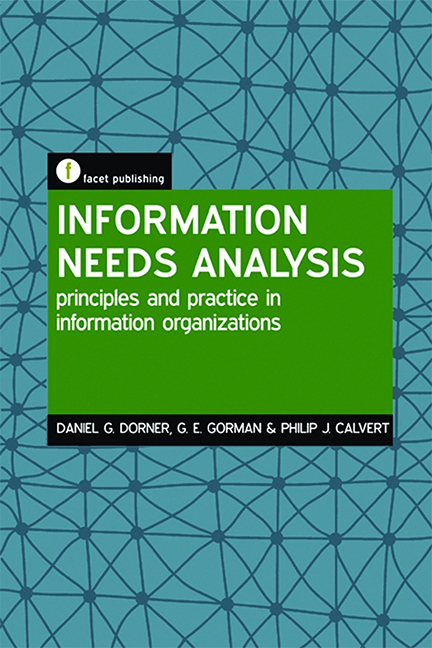Book contents
- Frontmatter
- Contents
- List of figures and tables
- List of scenarios
- About the authors
- Preface
- 1 Background to needs analysis for information managers
- 2 The importance of context in information needs analysis
- 3 Models and types of information needs analysis
- 4 The stages of information needs analysis
- 5 Gathering data for information needs analyses
- 6 Gathering data from existing sources
- 7 Gathering data through surveys
- 8 Gathering data through interviews
- 9 Analysing and integrating information needs analysis data
- 10 Reporting on an information needs analysis
- Bibliography
- Index
9 - Analysing and integrating information needs analysis data
Published online by Cambridge University Press: 10 September 2022
- Frontmatter
- Contents
- List of figures and tables
- List of scenarios
- About the authors
- Preface
- 1 Background to needs analysis for information managers
- 2 The importance of context in information needs analysis
- 3 Models and types of information needs analysis
- 4 The stages of information needs analysis
- 5 Gathering data for information needs analyses
- 6 Gathering data from existing sources
- 7 Gathering data through surveys
- 8 Gathering data through interviews
- 9 Analysing and integrating information needs analysis data
- 10 Reporting on an information needs analysis
- Bibliography
- Index
Summary
Introduction
In this chapter we focus on the analysis and integration of data that have been gathered to identify and make decisions about the information needs being investigated. In an INA project the analysis and integration of data occur not only towards the end of the project but also must be done to varying degrees throughout the project and for different purposes at different times.
In Chapter 4 we identified the four stages of INA projects: (1) preparation, (2) information (or data) gathering, (3) information (or data) analysis and (4) reporting the results. (Note that here we will refer to ‘data gathering’ rather than ‘information gathering’ and ‘data analysis’ rather than ‘information analysis’.) As explained below, the INA process is not strictly a linear one. It is iterative, so the information analysis stage may occur several times during a larger INA project, requiring the investigator to integrate several types of data.
In this chapter we examine when and how to analyse the information collected to determine the needs of the target group, bearing in mind that the project might involve several iterations of the various stages. We look at both qualitative and quantitative types of data and the processes used to analyse them. The extent of an analysis will depend on why the information was gathered, with analyses conducted during Stage 2 usually requiring more detail than those conducted during Stage 1 of an INA. Regardless of the stage at which data analysis is being undertaken, any issues that might affect the validity and reliability of the results must be considered.
Worth remembering is that INAs are not conducted solely to provide diagnostic data about the information needs of individuals; rather, they are conducted for a range of specific purposes, such as to determine priorities for providing new resources, programmes or systems, or to make improvements to existing ones, for groups in specific information-related contexts. The purpose must be kept in mind when making decisions throughout the INA. Also worth remembering is that the data analysis is intertwined with the kind of reporting expected from the investigation. If the INA requires formal reporting, then it probably will be necessary to apply procedures for analysing data that are recommended in academic research texts, but there will be times when other, perhaps less complex, data analysis methods are more appropriate.
Information
- Type
- Chapter
- Information
- Information Needs AnalysisPrinciples and Practice in Information Organizations, pp. 189 - 218Publisher: FacetPrint publication year: 2017
